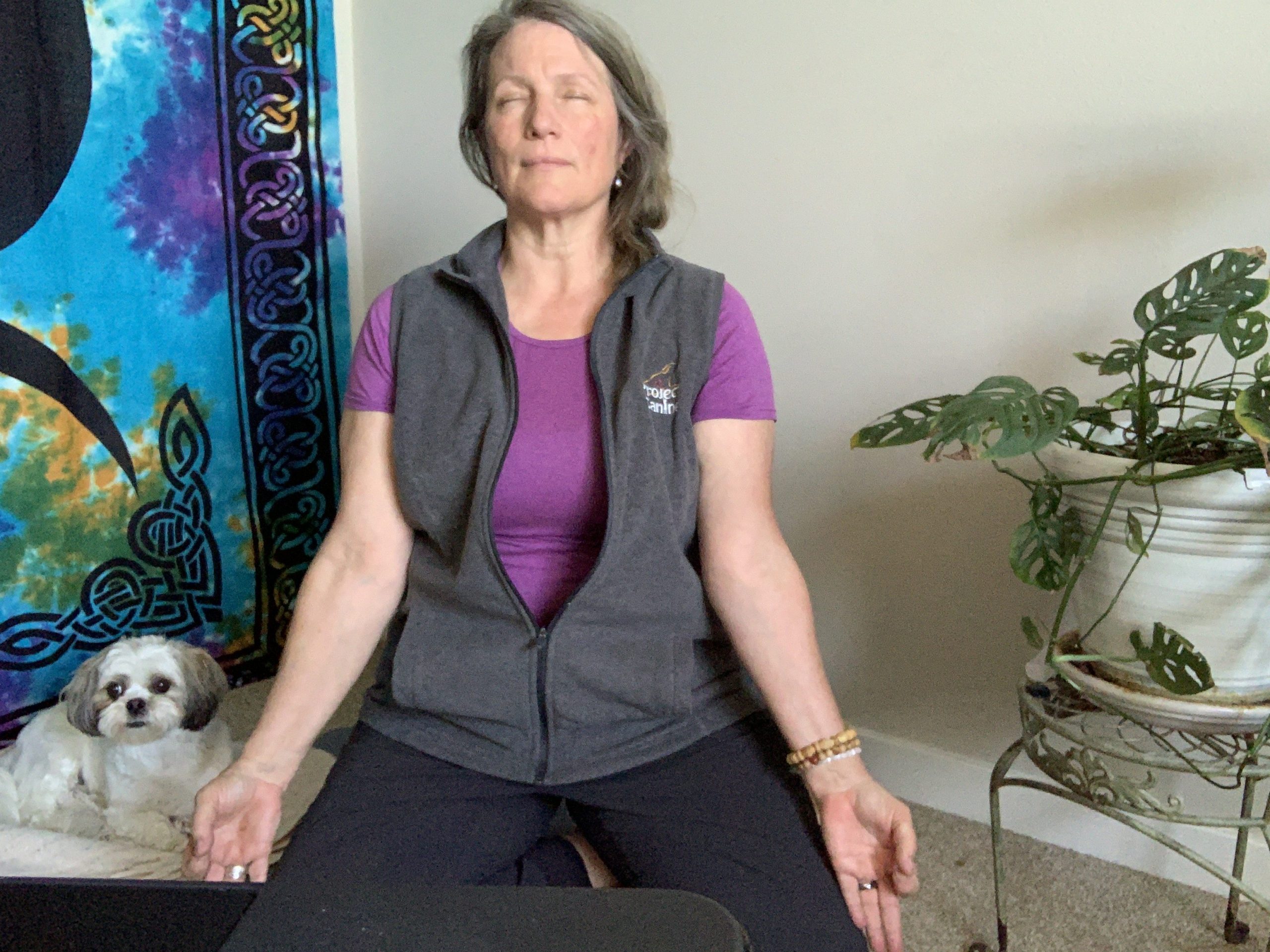{*Did you know you can write on Elephant? Here’s how—big changes: How to Write & Make Money or at least Be of Benefit on Elephant. ~ Waylon}
In the photo, my dog is more present and mindful than I am in this moment.
Hear me out for the whys. And if this is your meditation posture, please take no offense; remember this is only my own perspective, and I mean no disrespect. However…read on.
Meditation, whether we are doing a simple, mindful breath awareness practice, or a more formal religious posture and practice, helps focus the mind out of conscious thinking mode—the BETA brainwave state of mental processing—and bring a focus either to the body sensations (maybe the breath) or to mantras, prayers, or songs in order to help us fully actualize as our truest selves, which is not our fears, angers, attachments, stories, and experiences, but aligned to our spiritual core, our soul, our heart. When this happens, we come into more balance, ease, and flow on a physical, mental, emotional, spiritual, and vibrational level.
So good, right?
Yes. However, if a religious, cultural, and historical piece of wisdom is plucked up out of its geographical home and adopted into a new culture, the history and purpose may be lost, misunderstood, or applied partially to the new culture and may not be doing what we think it is doing. Hence, the problem with the above meditation shape.
Problem #1: Making more stress with muscle tension.
My hands are pressed against my legs, arms locked, creating tightness in my low spine, my arms, my hands, my fingers. That tension is flowing all the way up my back into my neck where I already have some stress tension, so it just makes all of that worse. Meditation is meant to happen in a place of softening down toward Earth with a gentle rise of the spine. With all this tension in my body, it’s nearly impossible to feel ease, so I have to force myself to try to be calm and force an empty mind. Resistance and tension just creates more resistance and tension.
People wonder why meditation is so hard! This particular physical posture is not creating physical ease and balance. It is not only making things difficult physiologically, and mentally and emotionally as well.
Problem #2: The mudra isn’t doing what you think.
Energy flows from the crown of the head through the brain down right off the fingertips and right off the toes. So when you bring your fingers together, you create a complete energy circuit. This is why yoga’s acupressure reflexology works so well to support health and well-being—mentally, emotionally, and physically.
Thumb and first finger together govern the release of what is not needed and help us center on gaining wisdom. If my hands and palms are upward, I am in a receiving posture. So energetically/spiritually, I’m saying I am ready to release whatever is holding me from gaining wisdom. That all sounds great, except with my hands on my legs I’m connecting to the energy of the root chakra. This is the energy that governs family connections, our roots, traditions, sexuality, and resources like finances.
So what we are telling our body in the language that our body speaks, which is vibration/energy/symbolism, is I want to release attachment to family, to roots, to finances…yikes!
What wasn’t passed down was the reason the shape was created; it was for monks in a monastery who needed to release so they could peacefully live a celibate life of poverty.
This pose was perfectly designed for exactly what they needed to focus on—development of wisdom and spirituality and release attachment to families, sexuality, and finances.
If this is what you want, great, but if not, let’s try something different.
Problem #3: Not starting from where you are. Or, head in the sand.
If I am shutting my eyes, I am shutting out the world. I know there are practices like Transcendental Meditation that teach this way, and if this is your practice, wonderful, but remember, mindfulness at its most useful helps us adapt to the world around us, not shut it out and hope it doesn’t exist for a minute. What if we were to look at mindful practices as a way of meeting life every day, every moment, with every breath? Especially in the hard moments. At the time of this photo, I was shutting my eyes and trying not to hear the trucks and traffic outside my window. Again, when we are in resistance mode, we are not in healing mode. Resistance in the head is no different than tension in my muscles.
My dog is alert, eyes open, body soft. He is fully connected to this moment, grounded and rooted, but also aware and present for life around us. His ease in body is a great teacher for me.
So, rather than try to resist or force or manage my surroundings, my brain…whatever is distracting, I just bring a curious objective noticing to life.
I say, “Yep. Traffic.” “Yep. Annoying beeping.” “Yep. Stressed mind.” And I turn my attention to the sensation of resting here on the earth; I turn toward gratitude for my aching muscles, my stress, my distractible and loveable brain.
Problem #4: There’s only one way.
Whatever your regular mindfulness practices are, the most important thing is to soften and be a little lighthearted about it. There’s no one way; there’s no absolute. Everything changes from day to day. Consistency doesn’t evolve or adapt and this is the quality we need most in these times of great change.
A meditation is an opportunity to love ourselves. To just notice our patterns and neurotic habits and take a moment to be present with what is. No judgement, no fear, no anger…just softening. Like the dog.
Thich Nhat Hahn said, “When you are drinking tea, just drink the tea.” I think he meant that throughout the day, enjoy those moments when you just focus on one thing rather than letting your mind go like a runaway train. Drop by drop we move toward more balance and harmony.
~
AUTHOR: TERRALEA DENNIS
IMAGE: AUTHOR'S OWN
EDITOR: ELYANE YOUSSEF


This account does not have permission to comment on Elephant Journal.
Contact support with questions.